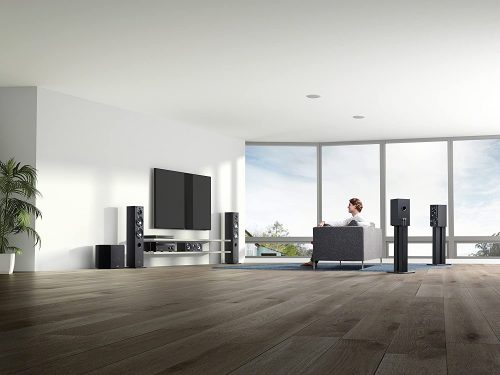
As a proud owner of a home theater system, you may face a new challenge – which is better to use, Bitstream or PCM?
To ensure your money isn’t wasted and to guarantee your audio needs are met, our team of sound experts decided to shed some light. In this article, we will discuss Bitstream vs PCM and and see how they work with a player and receiver.
Bitstream VS PCM
What is Bitstream
Before we get into our Bitstream vs PCM comparison, we must first discuss both audio applications. Bitstream, also known as a binary sequence, is a sound conversion system that translates the analog output audio signal into digital bits, transferring the information to a receiver. The Bitstream process starts when you decide what surround sound format to use.
Next, it will encode the audio signal into digital bits in the chosen format. After the process is complete, these bits will go to a disc (such as a Blu-ray player), a streaming source, a physical Connection (HDMI cable, coaxial output, or digital optical), a receiver, or embedded in TV transmissions.

Surround sound formats that use the Bitstream are Dolby, Dolby Digital, Plus, EX, TrueHD, DTS, DTS ES, Atmos, DTS 96/24, DTS HD-Master Audio, and DTS X. This method of transmitting audio files is common for modern home theater systems and disc players.
Advantages of Bitstream
An advantage of Bitstream is that the transmission of signal is done both wirelessly and through cables, and the support for digital optical or coaxial output goes up to 5.1 channels. Our experts tested Bitstream and noticed that more flexibility is offered to a processor, receiver and speakers, especially with devices that do not have an HDMI[1] connection. This will save you from spending a fortune on new sound systems. It is a way to still enjoy your old upgraded Blu-ray format devices.
An important advantage of using Bitstream decoding in your home theater is that less tension is put on the Blu-ray players because the encoding is done at the receiver level. A Blu-ray player produces high quality images and audio which Bitstream is capable of supporting.
Disadvantages of Bitstream
A big disadvantage of using Bitstream in your home theater appears when you want to use the secondary audio function. The quality of supplementary audio tracks is not very good.

The goal of Bitstream decoding is to offer the best surround sound experience without the need for secondary audio for formats such as Blu-ray for example. This means that if you use Bitstream for a program that uses high-resolution secondary audio like Dolby True HD, DTS HD-Master Audio, optical connection formats, Blu-ray or higher for the receiver, the audio output will be limited to standard definition.
One other problem is that Bitstream does not offer analog output support and only digital optical. That means that your options are limited to a receiver and player that handles digital sound transmission.
When to Use Bitstream
Our team recommends you to use Bitstream when you want to get the best experience from your home theater 5. 1 surround system while using optical or coaxial output cables. Bitstream will send a Dolby Digital or DTS 5. 1 surround sound signal to a receiver, while PCM is limited to a 2-channel signal. Your receiver will display Dolby, Dolby TrueHD, DTS HD Master Audio, Dolby Atmos, DTS, or other high-resolution audio formats.
In case you use a high-quality processor for your AVR, preamplifier, processor, TV, soundbar, or Blu-ray player, you should set it to Bitstream. The whole audio experience will be much better. You may use the Dolby Digital codec for audio coding to reduce the amount of data required to produce high-quality sound.
Also, to get the processing pressure off your media players, Bitstream is the option you must select.
When to Use Bitstream
Our team recommends you to use Bitstream when you want to get the best experience from your home theater 5. 1 surround system while using optical or coaxial output cables. Bitstream will send a Dolby Digital or DTS 5. 1 surround sound signal to a receiver, while PCM is limited to a 2-channel signal. Your receiver will display Dolby, Dolby TrueHD, DTS HD Master Audio, Dolby Atmos, DTS, or other high-resolution audio formats.

In case you use a high-quality processor for your AVR, preamplifier, processor, TV, soundbar, or Blu-ray player, you should set it to Bitstream. The whole audio experience will be much better. You may use the Dolby Digital codec for audio coding to reduce the amount of data required to produce high-quality sound.
Also, to get the processing pressure off your media players, Bitstream is the option you must select.
What is PCM
PCM, or pulse code modulation, represents the process of converting sampled analog output audio signals into digital signals for your disc player. This method of audio conversion is used in different audio applications like Blu-ray, or other disc players. PCM is the oldest method of transmitting audio data also used in telecommunications and radio.
If used in a home theater system or PS4 gaming console, PCM is often referred to as linear pulse code modulation or LPCM.
PCM signal is uncompressed. Therefore, it requires more bandwidth transmission space for your player. So if you are using a digital optical or coaxial output cable connection from your Blu-ray player or disc player to your home theater AVR, only two PCM audio channels may be transferred. This can be resolved by using an HDMI audio output.
Advantages of PCM
When you use PCM, your options are not limited only to high-tech players. PCM works with most Blu-ray player, or CD and DVD disc player options available on the market.

In terms of transmission, PCM may be used for a player and receiver that support both analog output and digital sound transmissions. The data transmission is direct and faster, and it can even eliminate any possible lag.
The decoding is being done in the Blu-ray disc players, meaning that there is less pressure on the receiver.
Another advantage is that if you set the Blu-ray disc players on PCM, it would work much better for secondary audio channels than Bitstream. In case you plan to use supplementary audio tracks such as audio commentaries or PIP audio, you will get a better audio quality.
Disadvantages of PCM
The PCM audio setting does not work with wireless connections. Since PCM transmits large uncompressed audio files, it will require a physical connection from the player to the AV receivers and speakers. Otherwise, the data will not be sent efficiently to the receiver.
Due to the fact that the players do the decoding, the audio quality partially depends on this device.
Another downside of PCM is the higher bandwidth required for a better audio output. Also, if you configure your system for digital optical audio or coaxial output connection, you should know that PCM is capable of transmitting only two-channel uncompressed signals.
Although this does not affect the audio quality for digital optical or coaxial, it may be unpleasant if you are looking for a better transmission option.
When to Use PCM
Our audio team recommends to check whether your audio player supports Bitstream format. If it doesn’t, the choice is simple – PCM is the only option you have for that player and even receiver.

Another reason for using PCM is the lack of an AV receiver. For example, if you don’t own a home theater system, soundbar or AV receiver, and you rely solely on the TV boxes, then you should opt for the PCM audio output.
Also, if you have an AV receiver that does not support Dolby TrueHD or DTS HD, PCM is the better setting of the two. Using the PCM configuration is also recommended whenever you want to unlock the secondary audio’s full potential.
Similarities Between Bitstream and PCM
Although Bitstream and PCM are two different transmissions that use different decode formats and methods for encoding the audio files in your player, both configurations deliver a high quality audio experience. Our team barely noticed any differences.
PCM and Bitstream files can be played in almost every DVD or Blu-ray player, so it depends on your preferences to choose which one works for you.
Both signals will require analog output conversion before hearing them in your speaker and player. Make sure your AV receiver supports both configurations. If it can, you will be able to switch between PCM audio output and Bitstream connections.
Differences Between Bitstream and PCM
As we already mentioned in this PCM vs Bitstream review, the sound quality is quite similar for any of these audio settings. However, there are some differences that you will have to be mindful of.

Perhaps the most important difference between PCM and Bitstream is the audio file quality that your player or receiver converts.
Bitstream works with coded files and supports more frequencies. It means that you will enjoy a higher quality audio if you put the audio output to Bitstream. On the other hand, PCM uses uncompressed raw signals which are not affected by codecs such as DTS or Dolby Digital on your player. The sound quality is also very good.
Although both settings offer you the best audio experience, you will not require a large bandwidth to send Bitstream data. PCM will need a wired connection as the files it transmits generally take a lot of space.
Another difference to be noted is related to the compatibility with audio devices. Bitstream is better for high-tech new home theater equipment, whereas PCM works very well with almost any Blu-ray disc player.
FAQ
What is the difference between linear PCM and bitstream?
The difference between Linear PCM and Bitstream is that Linear PCM provides encoding for 7.1 soundtracks while Bitstream supports up to 5. 1. Do note that LPCM audio quality is the same as for Bitstream option because it is not compressed.
Which is better linear PCM or Bitstream ps4?
The general opinion among gamers is that Linear PCM works great for HDMI, 5.1, and 7.1 digital sounds. However, using the Bitstream Dolby in most PS4 games setup will give a more realistic audio experience.
Should I set my TV to PCM or Bitstream?
You should set your TV to PCM if you don’t have a home theater system or a soundbar and you have to only rely upon the TV’s speakers. Lacking a receiver, Bitstream will decode the sound and will be great for your Blu-ray player and more.
What does PCM stand for audio?
PCM stands for pulse coded modulation. It represents an audio decoding setting when an external device connected via HDMI has already processed the sound. You will need to use PCM if you want the sound to come from the TV speakers.
Conclusion
After reviewing these two popular audio decoding settings, it was hard to pick a winner between PCM vs Bitstream. Both audio decoding configurations provide high-quality audio experiences; only the process differs. Depending on the device you own, the existence of a surround sound system, and other factors, you will want to choose the best setting for you carefully.
In case you need to set up a home theater system, Bitstream is the best option. For watching TV without any other external device, PCM will make a better choice for your setup.
The post Bitstream vs PCM — Which One Is Better For Audio? (2021) appeared first on The Product Analyst.
from The Product Analyst https://theproductanalyst.com/bitstream-vs-pcm/
No comments:
Post a Comment